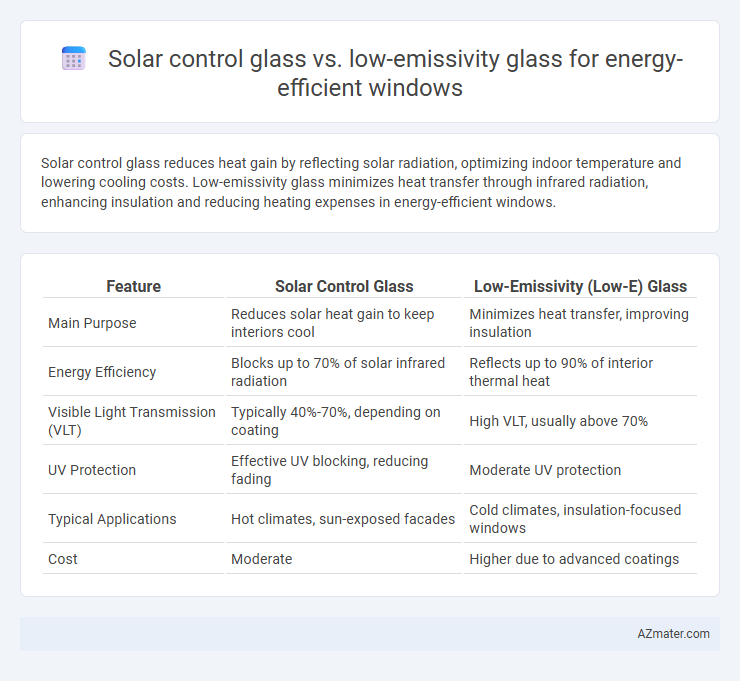Solar control glass reduces heat gain by reflecting solar radiation, optimizing indoor temperature and lowering cooling costs. Low-emissivity glass minimizes heat transfer through infrared radiation, enhancing insulation and reducing heating expenses in energy-efficient windows.
Table of Comparison
| Feature | Solar Control Glass | Low-Emissivity (Low-E) Glass |
|---|---|---|
| Main Purpose | Reduces solar heat gain to keep interiors cool | Minimizes heat transfer, improving insulation |
| Energy Efficiency | Blocks up to 70% of solar infrared radiation | Reflects up to 90% of interior thermal heat |
| Visible Light Transmission (VLT) | Typically 40%-70%, depending on coating | High VLT, usually above 70% |
| UV Protection | Effective UV blocking, reducing fading | Moderate UV protection |
| Typical Applications | Hot climates, sun-exposed facades | Cold climates, insulation-focused windows |
| Cost | Moderate | Higher due to advanced coatings |
Introduction to Energy-Efficient Windows
Energy-efficient windows use advanced glazing technologies to reduce heat transfer and improve insulation, significantly lowering energy consumption. Solar control glass reflects and absorbs a large portion of solar radiation, reducing cooling loads in warm climates by minimizing heat gain. Low-emissivity (Low-E) glass features a microscopically thin coating that limits infrared heat transfer while maintaining visible light transmission, enhancing insulation performance in various climates for year-round energy savings.
What is Solar Control Glass?
Solar control glass is designed to reduce solar heat gain by reflecting and absorbing a significant portion of the sun's infrared radiation, helping maintain cooler indoor temperatures and lowering air conditioning costs. Unlike low-emissivity (Low-E) glass, which primarily limits heat transfer through infrared radiation to retain internal warmth, solar control glass specifically targets the reduction of solar energy penetration. This type of glass often incorporates coatings or tints that enhance energy efficiency in windows by blocking excessive solar radiation while allowing natural light to pass through.
Understanding Low-Emissivity (Low-E) Glass
Low-emissivity (Low-E) glass features microscopically thin coatings that reflect infrared energy while allowing visible light to pass, effectively reducing heat transfer and enhancing energy efficiency in windows. Compared to solar control glass, which primarily blocks solar heat and glare, Low-E glass provides superior insulation by minimizing heat loss in winter and limiting heat gain in summer. This technology significantly improves indoor comfort and reduces heating and cooling costs, making Low-E glass a preferred choice for energy-efficient building designs.
Key Differences: Solar Control vs Low-E Glass
Solar control glass primarily reduces solar heat gain by reflecting and absorbing sunlight, making it ideal for hot climates to minimize cooling costs. Low-emissivity (Low-E) glass features a microscopically thin coating that limits infrared and ultraviolet light passage while maintaining visible light transmission, enhancing insulation and reducing heat loss in colder temperatures. Choosing between solar control and Low-E glass depends on climate and energy efficiency goals, with solar control suited for heat reduction and Low-E glass focused on thermal insulation.
Thermal Performance Comparison
Solar control glass significantly reduces solar heat gain by reflecting a large portion of infrared radiation, making it ideal for hot climates to maintain cooler indoor temperatures. Low-emissivity (Low-E) glass enhances thermal insulation by minimizing heat transfer through its microscopically thin metallic coating, retaining indoor warmth in colder environments. Combining solar control glass properties with Low-E coatings results in optimal thermal performance, balancing heat rejection and retention for year-round energy efficiency.
Impact on Natural Light Transmission
Solar control glass reduces solar heat gain by reflecting a significant portion of infrared and ultraviolet rays, which slightly lowers natural light transmission but effectively minimizes glare and interior heat buildup. Low-emissivity (Low-E) glass incorporates a microscopically thin coating that selectively filters infrared radiation while maintaining high visible light transmission, enhancing daylighting without increasing heat gain. Choosing between these glass types depends on balancing energy efficiency goals with the desired level of natural light and glare control in building design.
Energy Savings and Cost Efficiency
Solar control glass significantly reduces solar heat gain, lowering cooling costs by blocking up to 70% of infrared radiation while maintaining visible light transmission, resulting in substantial energy savings in warm climates. Low-emissivity (Low-E) glass improves insulation by minimizing heat transfer through its microscopic metallic coating, enhancing energy efficiency year-round by retaining indoor heat in winter and reflecting external heat in summer. Both options offer cost efficiency through reduced HVAC expenses, with solar control glass often favored for hot environments and Low-E glass providing a balanced solution for varied climates and insulation needs.
Best Applications for Solar Control Glass
Solar control glass excels in reducing solar heat gain and glare, making it ideal for commercial buildings with large facades and residential spaces in hot climates where minimizing cooling loads is critical. This glass type is particularly effective in office buildings, shopping centers, and high-rise apartments that require significant daylight without the associated heat increase. Its ability to block infrared and ultraviolet rays while maintaining natural light enhances comfort and energy efficiency, especially in regions with intense sunlight exposure.
Ideal Uses for Low-Emissivity Glass
Low-emissivity (Low-E) glass is ideal for energy-efficient windows in climates with extreme temperature variations, as it minimizes heat transfer by reflecting infrared energy while allowing visible light to pass through. It is particularly effective in residential and commercial buildings aiming to reduce heating and cooling costs by improving insulation without sacrificing natural daylight. Low-E glass is well-suited for south-facing windows that receive intense sunlight, helping to maintain indoor comfort and reduce reliance on HVAC systems year-round.
Choosing the Right Glass for Your Needs
Solar control glass significantly reduces solar heat gain, making it ideal for hot climates where minimizing cooling costs is a priority. Low-emissivity (Low-E) glass enhances insulation by reflecting interior heat back into the room, which is most effective in colder regions to conserve heating energy. Selecting the right glass depends on your local climate and energy goals--solar control glass for blocking heat in warm environments and Low-E glass for retaining heat in cooler settings.

Infographic: Solar control glass vs Low-emissivity glass for Energy-efficient window
 azmater.com
azmater.com